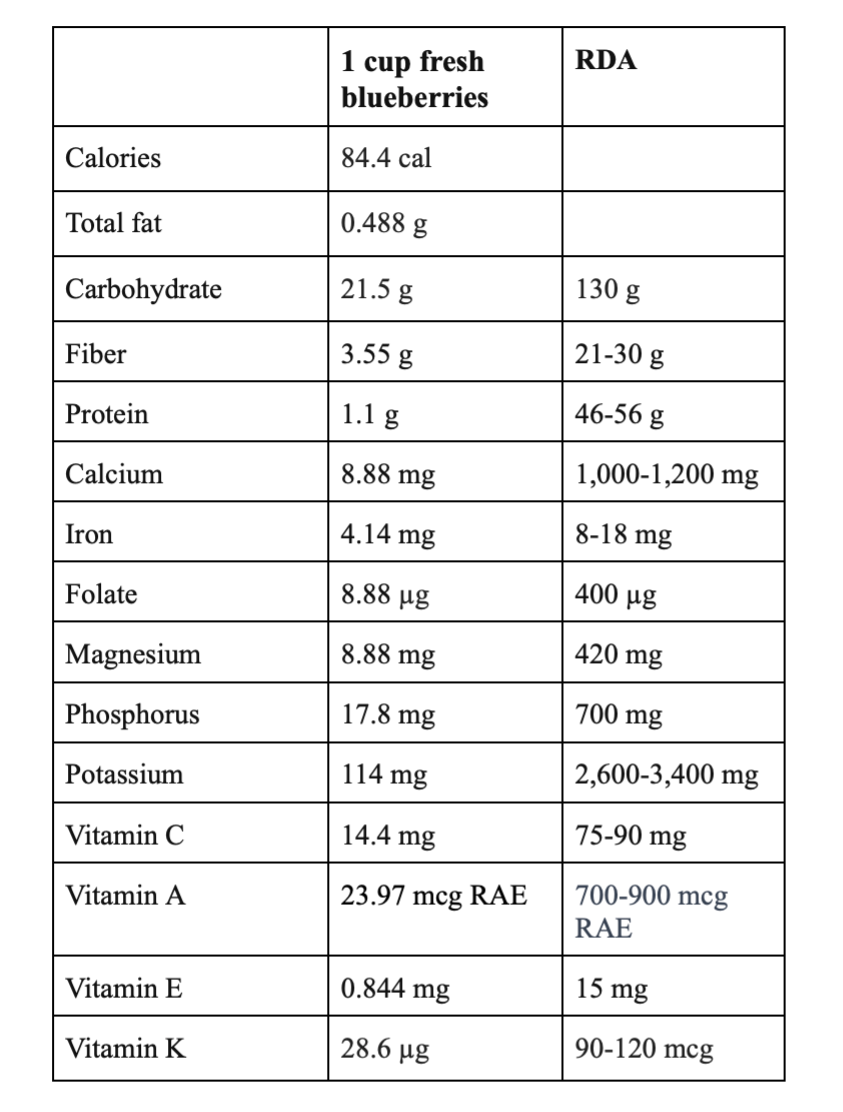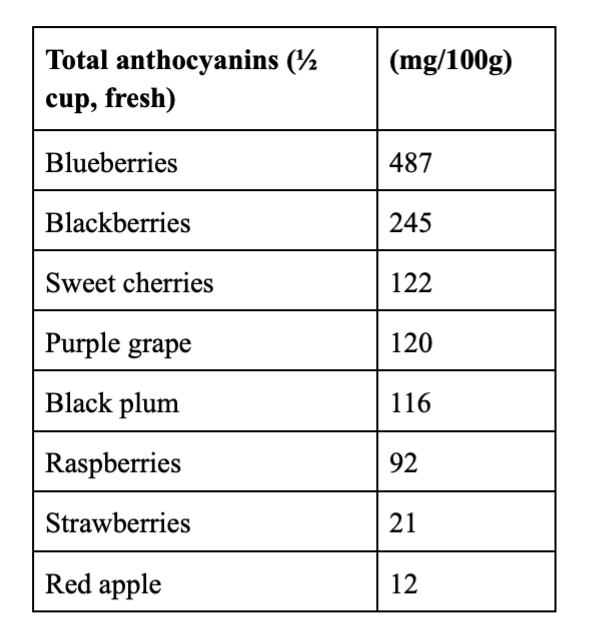Blueberries are not only delicious and nutritious, but research shows they may also help manage blood sugar and insulin levels. Learn how enjoying these berries can support your health.
Whether eaten as a snack, in smoothies, salads, baked goods, or jams, blueberries are one of nature’s most amazing gifts. These tiny berries are packed with nutrition that can boost your health and well-being. Whether you eat them fresh, frozen, or dried, blueberries can add a burst of flavor and color to your diet. Surprisingly, blueberries have also been found to positively impact blood sugar control in individuals with type 2 diabetes.
Blueberries are a nutritional powerhouse
Blueberries have earned their superfood status for a good reason: they are loaded with antioxidants, vitamins, minerals, and fiber. Here is the nutritional breakdown of blueberries and the recommended nutrient Recommended Dietary Allowance (RDA) for people 31 to 70 years old.

Like all berries, including cranberries, blueberries, blackberries, raspberries, and strawberries, blueberries contain polyphenols, which are plant compounds that have antioxidant, anti-cancer, and heart-protective effects. Anthocyanins, a type of polyphenol, are the predominant compounds found in ripe blueberries, constituting approximately 60% of the total polyphenol content. Anthocyanins are a plant pigment that gives fruits and vegetables red, blue, or purple colors. Compared to other fruits rich in anthocyanins, blueberries are particularly impressive for their elevated concentration of these compounds. See how blueberries stack up against other fruits in anthocyanins content.


How berries help regulate blood sugar and insulin levels
Type 2 diabetes is a condition where your body does not use insulin properly, which causes your blood sugar to get too high. Research suggests that along with their antioxidant, anticancer, and cardioprotective effects, berries can exert several beneficial effects on blood sugar and insulin resistance, specifically helping regulate insulin and blood sugar levels after a meal.
First, the anthocyanins in berries stimulate the secretion of the appetite-related gut hormone pancreatic polypeptide and slow the increase in blood sugar after eating. Pancreatic polypeptide is a hormone that reduces appetite and slows down digestion. The pancreas releases it after a meal, especially one that contains protein and fat. By affecting pancreatic polypeptide, berries can make people feel fuller for longer and reduce the risk of obesity and type 2 diabetes.
The anthocyanins in berries can also help keep blood sugar steady after eating by changing how much glucagon-like peptide-1 (GLP-1) is made. GLP-1 is a hormone that helps lower blood sugar by producing more insulin, slowing digestion, and reducing how much sugar the liver makes. GLP-1 also slows down the rate at which food empties from your stomach, and it acts on the brain to make you feel full and satisfied.
Additionally, berries may regulate energy balance by counteracting leptin resistance, a condition that often goes hand in hand with insulin resistance and type 2 diabetes. Leptin is a hormone that helps regulate appetite and energy balance by signaling the brain when the body has enough fat and calories. Leptin resistance means the brain does not respond appropriately to leptin and thinks the body is starving, even when it has enough or excess fat and calories. This leads to increased hunger, overeating, and weight gain. Being overweight or having obesity are risk factors for type 2 diabetes.
Finally, berries may also delay post-meal blood sugar responses by inhibiting carbohydrate digestion and absorption in the intestine. This counteracts the blood sugar-elevating effect of carbohydrates like white bread or added table sugar when eaten with berries, reducing post-meal blood sugar and insulin responses.
The research on how blueberries can boost blood sugar and insulin health in at-risk populations
Some experts suggest that blueberries outperform other berries in terms of their positive impact on blood sugar and insulin health. They have been shown to reduce the risk of developing type 2 diabetes by an impressive 26%, making them a top choice for promoting optimal blood sugar regulation.

Here are some research findings that illustrate how blueberries can enhance blood sugar and insulin control in people with type 2 diabetes or metabolic syndrome.
- One double-blind, randomized control trial examined how a single exposure to blueberries along with a high-fat and high-sugar beverage affected the post-meal insulin and blood sugar response over 24 hours. Forty-five participants with metabolic syndrome were given a 969-calorie drink with either 26g of freeze-dried blueberry powder equivalent to 1 cup of fresh blueberries or 26g of placebo powder. Blood samples were collected at various time points (at 30, 60, 90, 120, 180, 360 minutes, and 24 hours) to assess insulin and blood sugar levels. The results showed that 3 hours post-drink, blueberries significantly lowered blood glucose and insulin levels compared to placebo. The blueberry group had an average blood glucose level of 77.4 mg/dL, while the placebo group had an average of 91.8 mg/dL. The blueberry group also had an average insulin level of 23.4 pmol/L, while the placebo group had an average of 52.9 pmol/L.This study suggests that blueberries can help people with metabolic syndrome lower their blood sugar and insulin levels after a high-calorie meal, which may reduce the risk of diabetes and cardiovascular complications.
- Another double-blind, randomized controlled trial investigated the effects of blueberries on various diabetes-related indicators. The study recruited 52 men with type 2 diabetes who were randomly assigned to one of two intervention groups. One group either consumed 11 g freeze-dried blueberries rehydrated with water or a placebo with their morning and evening meals along with their typical diet for 8 weeks. HbA1c (a measure of average blood sugar level over the past two to three months), fasting plasma glucose concentrations (a measure of blood sugar level after not eating for at least 8 hours), and serum insulin (a measure of the amount of insulin in the blood) were measured at baseline and again after the 8-week study period. The researchers found that although fasting plasma glucose and serum insulin were not statistically different between the two groups at 8 weeks, those eating blueberries daily experienced beneficial effects on their HbA1c compared to those who did not. Specifically, HbA1c was 7.1% in the blueberry group, while the average blood sugar level in the placebo group was 7.5%.
The American Diabetes Association (ADA) encourages people to consume fruit in a balanced way as part of a healthy diet because of their health-enhancing nutrients, and it specifically endorses fresh berries as a “superstar” food for people living with type 2 diabetes. So enjoy blueberries in many ways, like eating them fresh, adding them to smoothies, baking them into low-sugar muffins, or freezing them for a cool snack.
The bottom line
Blueberries are a delicious and versatile fruit that offer many health benefits. They are rich in antioxidants, fiber, and vitamins that can promote your health. If you have type 2 diabetes or metabolic syndrome, blueberries can also help you control your blood sugar and insulin levels by slowing digestion and improving insulin sensitivity. Blueberries are a superfood that you can incorporate into your diet all year round.

Sources:
- https://fdc.nal.usda.gov/fdc-app.html#/food-details/171711/nutrients
- https://nap.nationalacademies.org/
- https://www.ncbi.nlm.nih.gov/pmc/articles/PMC7202899/
- https://www.ncbi.nlm.nih.gov/pmc/articles/PMC2835915/
- https://academic.oup.com/advances/article/11/2/224/5536953
- https://www.ncbi.nlm.nih.gov/pmc/articles/PMC5613902/#:~:text=Anthocyanins%20are%20blue%2C%20red%2C%20or,anthocyanin%20exists%20in%20alkaline%20conditions.
- https://diabetes.org/diabetes/type-2
- https://www.ncbi.nlm.nih.gov/pmc/articles/PMC3349792/#:~:text=Pancreatic%20Polypeptide%20(PP)%20is%20a,in%20glucose%20release%20from%20liver.
- https://www.gastrojournal.org/article/S0016-5085(07)00580-X/fulltext?referrer=https%3A%2F%2Fen.wikipedia.org%2F
- https://www.ncbi.nlm.nih.gov/pmc/articles/PMC6354688/
- https://www.cdc.gov/chronicdisease/resources/publications/factsheets/diabetes-prediabetes.htm#:~:text=Top%20of%20Page-,Overweight%20and%20Lack%20of%20Physical%20Activity,adults%20have%20overweight%20or%20obesity.
- https://www.ncbi.nlm.nih.gov/pmc/articles/PMC8757535/
- https://www.ncbi.nlm.nih.gov/pmc/articles/PMC7170047/
- https://diabetes.org/healthy-living/recipes-nutrition/eating-well/fruit





